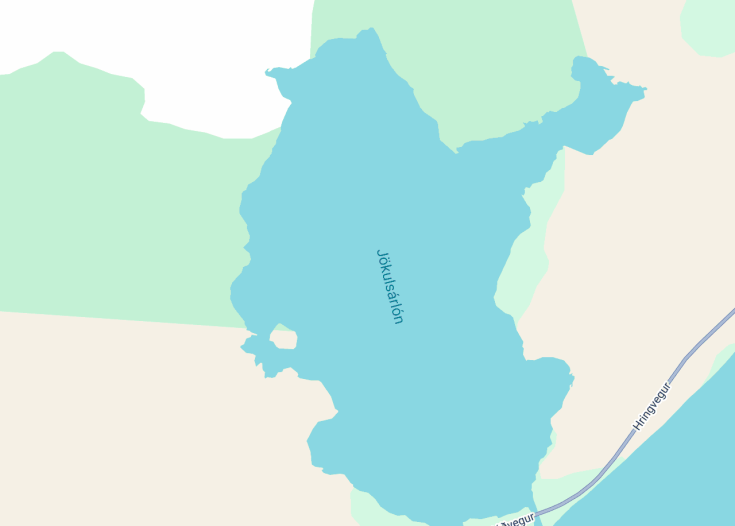Jökulsárlón, a stunning glacial lagoon in Iceland, is renowned for its breathtaking beauty and dynamic environment. Situated at the edge of Vatnajökull National Park, the lagoon forms part of the larger glacier and evolves continuously as huge blocks of ice calve off the glacier and drift serenely in the icy waters. Visitors are captivated by the dramatic scenery, which includes crystal-clear blue icebergs and the occasional sighting of seals swimming amongst the ice. Jökulsárlón is not just a natural wonder but also a vivid reminder of nature’s power and transience.
To capture stunning photographs, visit during the golden hour for dramatic lighting over the icebergs, especially during summer when the midnight sun casts a surreal glow over the lagoon.
Consider taking a guided boat tour for an up-close experience with the floating icebergs. It’s an unforgettable way to learn about the glacier’s ecology and spot wildlife.
Jökulsárlón: a mirror to the arctic
Located in the southeast of Iceland, Jökulsárlón is a stunning glacial lagoon that has become one of the top tourist attractions in the country. Formed by the receding Breiðamerkurjökull Glacier, part of the larger Vatnajökull Glacier, this breathtaking lagoon is renowned for its icy waters and towering icebergs. The blue and white ice chunks, which break off from the glacier, offer a dynamic and ever-changing landscape that mesmerizes visitors.
The lagoon drains into the Atlantic Ocean, creating a unique spectacle where these icebergs float and slowly melt away. Jökulsárlón also serves as an important habitat for wildlife, particularly for seals who are commonly seen lounging on the icebergs.
With its crystal-clear ice and the dramatic sounds of ice breaking, the lagoon provides an exceptional natural experience. Furthermore, the nearby Diamond Beach, where icebergs wash up on the black sand, offers stark and beautiful contrasts that are a photographer’s dream.
Exploring Jökulsárlón’s icy wonders
Visitors to Jökulsárlón can engage in a variety of activities that highlight the lagoon’s natural beauty and serene atmosphere. Boat tours are highly popular, offering close encounters with the floating icebergs and an opportunity to witness the glacier up close. Options include amphibian boat tours, which are suitable for all ages, and more adventurous zodiac boat tours, which provide a faster-paced experience.
Seasonal Variations
Depending on the season, visitors might also experience different aspects of the lagoon—ranging from vibrant summer scenes to the quiet, frozen expanses during winter. Additionally, kayaking among the icebergs presents an intimate way to explore the lagoon’s tranquil environment. For those who prefer to stay on land, there are well-marked pathways around the lagoon that offer spectacular viewpoints and photo opportunities.
Mystical nights at jökulsárlón: auroras and ice
Jökulsárlón not only captivates during the day but also offers one of the most magical experiences during the night. As the sun sets and darkness envelops the lagoon, the chances of witnessing the Northern Lights, or Aurora Borealis, increase. The reflection of the colorful auroras on the icy surface of the lagoon creates a surreal scene, combining the greens and blues of the sky with the whites and blues of the ice.
This phenomenon makes Jökulsárlón a favorite spot for photographers and nature enthusiasts seeking to capture or just experience this breathtaking natural light show. Since this occurrence is highly dependent on weather conditions and solar activity, the best months to experience the Northern Lights here are between September and April.
Explore the captivating Jökulsárlón
Suitable for adventurers, nature lovers, and photography enthusiasts of all ages, Jökulsárlón offers an unforgettable experience. This glacial lagoon, famous for its stunning icebergs and serene natural environment, provides a unique adventure that is both educational and exhilarating.
Visitors can expect to be mesmerized by the sheer beauty of ice floating on the tranquil water, coupled with the possibility of spotting wildlife such as seals.
Whether you’re a family looking for an engaging day out, a couple seeking a romantic escape, or a solo traveler eager to capture nature’s wonders, Jökulsárlón is an ideal destination.
When to visit the enchanting Jökulsárlón
The best time to visit Jökulsárlón is between May and August, when the weather is most favorable, and the icebergs are vividly visible in the lagoon. Daylight extends for almost 24 hours in the peak of summer, offering extended viewing times of the stunning scenery.
Annual Iceberg Festival
For those looking for a special time to visit, the Annual Iceberg Festival in July is a not-to-be-missed event, celebrating the peak of iceberg formations with guided tours and cultural performances.
Accessibility and limitations at Jökulsárlón
Understanding the limitations of visiting Jökulsárlón is important for planning your trip.
Accessibility
Limitations
- Weather conditions: Rapid changes in weather can restrict access.
- Parking: Limited during high season periods.
Notes to visitors
- Drones: Use of drones must be with permission only.
- Boat Tours: Subject to weather conditions and can be cancelled last minute.
General informations
Plan your visit to Jökulsárlón effectively
Location
Located near Vatnajökull National Park, easily reachable via the Ring Road circumnavigating Iceland.
Address: Jökulsárlón Lagoon Entrance, Fagurhólsmýri, Iceland
Opening hours
The site is open year-round, 24 hours a day. However, boat tours operate from May to September, 10:00 AM to 5:00 PM.
How to reach Jökulsárlón
Car
Jökulsárlón is best reached by car. It provides flexibility to explore surrounding areas.
| Route | Distance | Travel time |
|---|---|---|
| From Reykjavik | 230 miles (370Km) | 5 hours |
| From Akureyri | 255 miles (410Km) | 5.5 hours |
| From Egilsstaðir | 200 miles (320Km) | 4.5 hours |
Public Transport
Buses operate from Reykjavik to Jökulsárlón during the summer months with a similar travel time as driving.
Nearby Attractions
Explore nearby attractions to maximize your experience in the region:
- Vatnajökull National Park – 5 miles (8 km)
- Fjallsárlón Iceberg Lagoon – 11 miles (17.7 km)
- Diamond Beach – 0.5 miles (0.8 km)
- Skaftafell Glacier – 45 miles (72 km)
- Ice Cave Tours – 10 miles (16 km)
- Svartifoss Waterfall – 52 miles (83.7 km)
- Glacier Hiking – 11 miles (17.7 km)
- Laki Craters – 78 miles (125.5 km)
- Black Sand Beach (Vik) – 116 miles (186.7 km)
- Eldhraun Lava Field – 60 miles (96.5 km)
- Skeiðará Bridge Monument – 42 miles (67.6 km)
- Hvannadalshnjúkur Peak – 48 miles (77 km)
Common questions
What wildlife can be seen around Jökulsárlón?
Can visitors swim in Jökulsárlón?
What is the best time of year to visit Jökulsárlón?
How was Jökulsárlón formed?
Are there any guided tours available at Jökulsárlón?
What safety measures should visitors consider at Jökulsárlón?
- Dress Appropriately: Wear warm, waterproof clothing and sturdy footwear to handle slippery surfaces and cold weather.
- Follow Signage and Barriers: Never attempt to walk on or near icebergs, as they can move or roll over unexpectedly.
- Avoid Swimming: As mentioned, the lagoon’s waters are extremely cold and can be dangerous.
- Use Qualified Tour Operators: When participating in boat tours or ice cave experiences, always use services from official and reputable operators to ensure safety standards are met.
Being prepared and aware of these factors will help ensure a safe and enjoyable visit.
What facilities are available at Jökulsárlón for tourists?
- Parking: Ample parking space available for visitors near the lagoon.
- Viewing Areas: Designated areas that offer spectacular views of the lagoon and its icebergs.
- Café: There is usually a café near the site, providing refreshments and light meals.
- Toilets: Public restrooms are accessible, located near the main parking area.
- Gift Shop: Souvenirs and local crafts can be purchased as mementos of your visit.
- Information Center: Available to offer guidance and information about the lagoon and surrounding areas.
These facilities help ensure convenience and comfort during your visit.
How do the changing seasons affect the scenery at Jökulsárlón?
- Spring: Ice melting intensifies, and the lagoon starts expanding, flushing out older icebergs and making way for new ones.
- Summer: The lagoon is at its most dynamic, with numerous icebergs floating around and wildlife activity at its peak. The landscape is lush, and flowers bloom in the nearby fields.
- Fall: The vistas start transforming drastically with stunning autumn colors; this is a transitional period with a mix of icebergs and the onset of the frost.
- Winter: The lagoon and surrounding areas are often covered in snow, creating a pristine, white landscape. Icebergs might freeze into place, giving a different perspective on the lagoon.
These seasonal cycles dictate not just the appearance but also the type of activities and experiences available at Jökulsárlón.

Is Jökulsárlón in Fagurhólsmýri worth visiting?
Jökulsárlón, a remarkable glacial lagoon located in Fagurhólsmýri, indisputably offers one of the most unique natural landscapes in Iceland. Known for its massive icebergs that break away from the nearby glacier and drift serenely in the lagoon, this site provides phenomenal photographic opportunities. The color palette ranging from turquoise to deep blue, contrasted with the pristine whites and icy greys of the floating ice, is simply mesmerizing.
Tourists can also experience boat tours, which allow for a closer examination of the ice formations and possibly sightings of local wildlife, including seals. Despite its beauty, Jökulsárlón can be overcrowded, particularly during peak tourist season. This sometimes affects the serenity that one might expect from such a remote location. Visitors should also prepare for potentially cold and unpredictable weather. Overall, the site’s natural beauty is extraordinary, making it well worth a visit for those who appreciate unique natural phenomena and don’t mind a bit of bustle.










